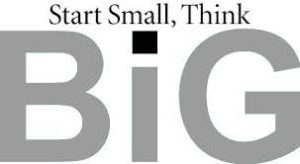
I know it sounds like a cliché, but it is very rare when anything in life starts big. Yet Jeff and I frequently hear leaders and managers in non-profits tell their MGOs to “go out there and find that big gift!!” I suppose that this directive is an aspiration born from seeing other organizations “land the big one” and wanting the same thing to happen in their organization.
So we don’t fault anyone for wanting to get the big gift. The problem is having the expectation without understanding how it is done.
Most people who do not have experience in major gifts truly believe it is simpler and faster than it really is. That is why I wanted to discuss why it is a bit more complex. The whole process of getting a bigger gift has, in our opinion, five steps:
An MGO’s belief that big things are possible. In our experience most MGOs do not think boldly enough. They do not believe that a donor will give as much as she actually can, so they plan low and ask low. You need to think big. Ask yourself this question: “Does the cause my organization represents deserve a very large gift from a donor who could give it?” I think you will say “yes.” So why not ask for it? You need to believe that big gifts from donors with high capacity and inclination can, indeed, happen. This is critical.
Having a qualified caseload. We have said this many times, and I know you must get frustrated hearing it over and over again. But the reason we keep repeating this is because we see MGOs everywhere trying to secure large gifts from donors who don’t even talk to them! How can you expect to secure a large gift if you don’t have a caseload of qualified donors who are engaged with you? You can’t.
Believing that you already have several donors who can give a large gift, and searching for them. It is an absolute truth that buried in your caseload are 2-5 donors who can give life- and organization-transforming gifts. We know this from years of experience. There is a logic to this point you must embrace.
Here is how that logic works. The donor made an initial decision to give to your organization because she bought into your promise to solve a problem she cared about IF she gave. So she gave. She is on board. Now you’ve discovered (because you are actively researching and searching for facts) that this donor, in addition to having inclination (she is currently giving), also has substantial capacity to give a transformational gift. Now the only thing between these facts and this donor giving a large gift is your making a compelling case that motivates the donor to make that gift.
It is more complicated than this, but this is the logic trail to getting the bigger gift. You have to identify at least five donors, in my opinion, where this logic matches the donor’s circumstances. Then you will have at least five chances to secure a large gift if you follow this process in a very detailed and strategic way.
Planning to make it happen. Here is where things tend to go wrong. The MGO has done all the research, picked out the few donors who could give large gifts, and then failed to make an executable plan to make it happen. To be executable, you need these critical elements in the plan:
- trust building steps
- reporting back touchpoints that tell the donor her current giving is making a difference
- a compelling and believable setup to the problem or situation
- the MGO wants the donor to give
- a series of personal meetings and encounters with the problem/situation and authority figures (CEO/Executive Director and Program folks) to do two things: (a) Create belief on the part of the donor that this is a real problem that can be solved, and (b) Create a belief that the donor’s gift will make a substantial difference.
Jeff and I have seen this happen over and over again, where a donor is exposed to a situation he is interested in and then, over time, he comes to believe that his substantial gift will make the situation better. This is how a MGO nurtures and orchestrates all the events up to the ask – helping the donor feel comfortable with his important role in solving the problem.
Accepting that all of this takes time. It goes without saying that the process I have described takes time, often more than a calendar or fiscal year. We have seen it take as little as six months and as long as 2 ½ years. The MGO needs to value the long term in this process, making contact with the donor, presenting new information, staying connected, and moving the process along at a pace that the donor is comfortable with.
These steps are not easy, but they do work, if you apply them systematically and patiently. Try it and see. In my next post I will share three real-life stories showing how this system worked successfully.
Richard





Board members and past Board members are often among an organization’s largest donors. Sometimes the relationships between the CEO and Board members become strained, for example when the Board wants to give advice as to strategy etc. and the CEO is not open to it, calling it micromanaging. A Capital Campaign is announced and the put-off Board members are asked and expected to give large gifts. But they are not feeling warmly toward the organization and its leadership at that point. How would you address this? Donors, and especially Board members, don’t want to be viewed just as sources of funding.
Hmmm. This is a tough one, Anita. Tough. Would there be a way to encourage the put-off board member to talk to the CEO about how he/she is feeling – that they would like to be able to contribute more to the ideas and strategy, etc? That might be one way to get at it. Another is to have the board member be part of development strategy planning – meetings where the CEO is not present. That way the board member is able to contribute and development is modeling (for the CEO) how to involve board members. Involving others for their ideas vs. their money is always a good thing to do. But it is difficult, I know, especially in hostile environments.